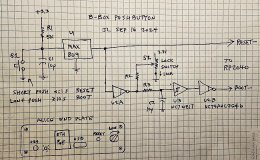john larkin
2024-09-17 02:58:04 UTC
The RP2040 has a cool mode where it can be made to boot up with the
USB port looking like a memory stick. That's great for software
installs or upgrades. The Pico board has a BOOT button on the board;
if the pico is powered up with the button pushed, it goes into that
boot mode.
But if I have a product (actually a family of products) in a nice
aluminum box, a user would have to remove the top cover, remove all
power sources (there can be three), and hold the button down while
reconnecting power.
Some of my customers also want to lock a box such that it's impossible
to write to any nonvolatile memory while it's in a secure area.
So here's an idea: a small hole in the box allows a toothpick or a
paper clip to push a button. A short push is a regular reset. A long
push is a memory-stick mode boot. We can have a rotary switch LOCK
hole too.
Loading Image...
Does that look like it will work? The paranoid customer can pave over
the two holes, and even the end-plate screws, with an official-looking
sticker.
Schmitt trigger U3 is unfortunate and likely unnecessary, but it
insures against a low-probability hazard.
USB port looking like a memory stick. That's great for software
installs or upgrades. The Pico board has a BOOT button on the board;
if the pico is powered up with the button pushed, it goes into that
boot mode.
But if I have a product (actually a family of products) in a nice
aluminum box, a user would have to remove the top cover, remove all
power sources (there can be three), and hold the button down while
reconnecting power.
Some of my customers also want to lock a box such that it's impossible
to write to any nonvolatile memory while it's in a secure area.
So here's an idea: a small hole in the box allows a toothpick or a
paper clip to push a button. A short push is a regular reset. A long
push is a memory-stick mode boot. We can have a rotary switch LOCK
hole too.
Loading Image...
Does that look like it will work? The paranoid customer can pave over
the two holes, and even the end-plate screws, with an official-looking
sticker.
Schmitt trigger U3 is unfortunate and likely unnecessary, but it
insures against a low-probability hazard.